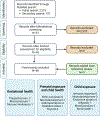Exposure to organophosphate esters and maternal-child health
- PMID: 38640988
- PMCID: PMC11152993
- DOI: 10.1016/j.envres.2024.118955
Exposure to organophosphate esters and maternal-child health
Abstract
Organophosphate esters (OPEs) are a class of chemicals now widely used as flame retardants and plasticizers after the phase-out of polybrominated diphenyl ethers (PBDEs). However, OPEs carry their own risk of developmental toxicity, which poses concern for recent birth cohorts as they have become ubiquitous in the environment. In this review, we summarize the literature evaluating the association between OPE exposure and maternal, perinatal, and child health outcomes. We included original articles investigating associations of OPE exposure with any health outcome on pregnant women, newborns, children, and adolescents. We found 48 articles on this topic. Of these, five addressed maternal health and pregnancy outcomes, 24 evaluated prenatal OPE exposure and child health, 18 evaluated childhood OPE exposure and child/adolescent health, and one article evaluated both prenatal and childhood OPE exposure. These studies suggest that OPE exposure is possibly associated with a wide range of adverse health outcomes, including pregnancy loss, altered gestational duration and smaller birthweight, maternal and neonatal thyroid dysfunction, child metabolic dysregulation and abnormal growth, impaired neurodevelopment, and changes in immune response. Many of the reported outcomes associated with OPE exposure varied by child sex. Findings also varied substantially by OPE metabolite and exposure time. The OPEs most frequently measured, detected, and found to be associated with health outcomes were triphenyl phosphate (TPHP, metabolized to DPHP) and tris(1,3-dichloro-2-propyl) phosphate (TDCIPP, metabolized to BDCIPP). The extensive range of health outcomes associated with OPEs raises concern about their growing use in consumer products; however, these findings should be interpreted considering the limitations of these epidemiological studies, such as possible exposure misclassification, lack of generalizability, insufficient adjustment for covariates, and failure to consider chemical exposures as a mixture.
Keywords: Child health; Endocrine disrupting chemicals; Epidemiology; Flame retardants; Maternal health; Organophosphate esters (OPEs).
Copyright © 2024 Elsevier Inc. All rights reserved.
Conflict of interest statement
Declaration of competing interest The authors declare that they have no known competing financial interests or personal relationships that could have appeared to influence the work reported in this paper.
Figures
References
-
- Ait Bamai Y, Araki A, Nomura T, Kawai T, Tsuboi T, Kobayashi S, Miyashita C, Takeda M, Shimizu H, & Kishi R (2018). Association of filaggrin gene mutations and childhood eczema and wheeze with phthalates and phosphorus flame retardants in house dust: The Hokkaido study on Environment and Children’s Health. Environ Int, 121(Pt 1), 102–110. 10.1016/j.envint.2018.08.046 - DOI - PubMed
-
- Araki A, Ait Bamai Y, Bastiaensen M, Van den Eede N, Kawai T, Tsuboi T, Miyashita C, Itoh S, Goudarzi H, Konno S, Covaci A, & Kishi R (2020). Combined exposure to phthalate esters and phosphate flame retardants and plasticizers and their associations with wheeze and allergy symptoms among school children. Environ Res, 183, 109212. 10.1016/j.envres.2020.109212 - DOI - PubMed
-
- Araki A, Bastiaensen M, Ait Bamai Y, Van den Eede N, Kawai T, Tsuboi T, Ketema RM, Covaci A, & Kishi R (2018). Associations between allergic symptoms and phosphate flame retardants in dust and their urinary metabolites among school children. Environ Int, 119, 438–446. 10.1016/j.envint.2018.07.018 - DOI - PubMed
-
- Bai XY, Lu SY, Xie L, Zhang B, Song SM, He Y, Ouyang JP, & Zhang T (2019). A pilot study of metabolites of organophosphorus flame retardants in paired maternal urine and amniotic fluid samples: potential exposure risks of tributyl phosphate to pregnant women. Environ Sci Process Impacts, 21(1), 124–132. 10.1039/c8em00389k - DOI - PubMed
Publication types
MeSH terms
Substances
Grants and funding
LinkOut - more resources
Full Text Sources


